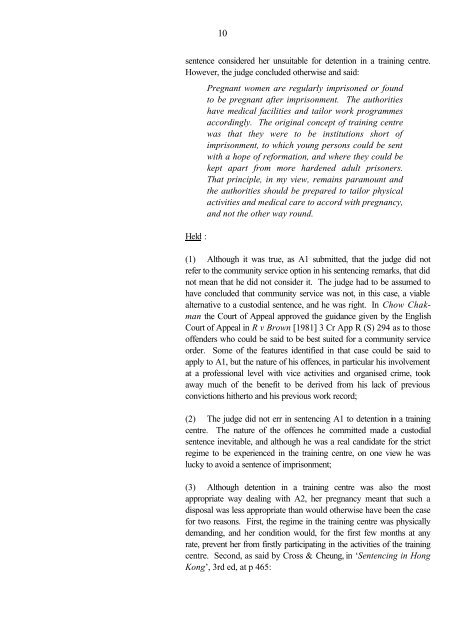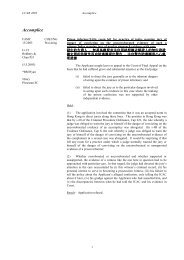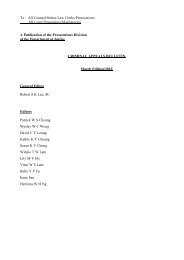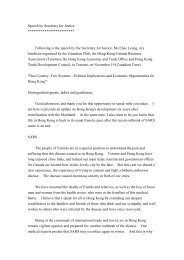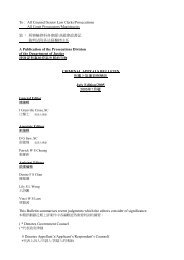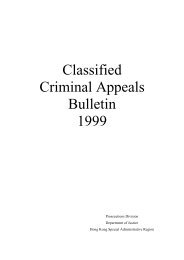刑事檢控科各律師/高級律政 - Department of Justice
刑事檢控科各律師/高級律政 - Department of Justice
刑事檢控科各律師/高級律政 - Department of Justice
You also want an ePaper? Increase the reach of your titles
YUMPU automatically turns print PDFs into web optimized ePapers that Google loves.
10<br />
sentence considered her unsuitable for detention in a training centre.<br />
However, the judge concluded otherwise and said:<br />
Held :<br />
Pregnant women are regularly imprisoned or found<br />
to be pregnant after imprisonment. The authorities<br />
have medical facilities and tailor work programmes<br />
accordingly. The original concept <strong>of</strong> training centre<br />
was that they were to be institutions short <strong>of</strong><br />
imprisonment, to which young persons could be sent<br />
with a hope <strong>of</strong> reformation, and where they could be<br />
kept apart from more hardened adult prisoners.<br />
That principle, in my view, remains paramount and<br />
the authorities should be prepared to tailor physical<br />
activities and medical care to accord with pregnancy,<br />
and not the other way round.<br />
(1) Although it was true, as A1 submitted, that the judge did not<br />
refer to the community service option in his sentencing remarks, that did<br />
not mean that he did not consider it. The judge had to be assumed to<br />
have concluded that community service was not, in this case, a viable<br />
alternative to a custodial sentence, and he was right. In Chow Chakman<br />
the Court <strong>of</strong> Appeal approved the guidance given by the English<br />
Court <strong>of</strong> Appeal in R v Brown [1981] 3 Cr App R (S) 294 as to those<br />
<strong>of</strong>fenders who could be said to be best suited for a community service<br />
order. Some <strong>of</strong> the features identified in that case could be said to<br />
apply to A1, but the nature <strong>of</strong> his <strong>of</strong>fences, in particular his involvement<br />
at a pr<strong>of</strong>essional level with vice activities and organised crime, took<br />
away much <strong>of</strong> the benefit to be derived from his lack <strong>of</strong> previous<br />
convictions hitherto and his previous work record;<br />
(2) The judge did not err in sentencing A1 to detention in a training<br />
centre. The nature <strong>of</strong> the <strong>of</strong>fences he committed made a custodial<br />
sentence inevitable, and although he was a real candidate for the strict<br />
regime to be experienced in the training centre, on one view he was<br />
lucky to avoid a sentence <strong>of</strong> imprisonment;<br />
(3) Although detention in a training centre was also the most<br />
appropriate way dealing with A2, her pregnancy meant that such a<br />
disposal was less appropriate than would otherwise have been the case<br />
for two reasons. First, the regime in the training centre was physically<br />
demanding, and her condition would, for the first few months at any<br />
rate, prevent her from firstly participating in the activities <strong>of</strong> the training<br />
centre. Second, as said by Cross & Cheung, in ‘Sentencing in Hong<br />
Kong’, 3rd ed, at p 465:


